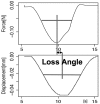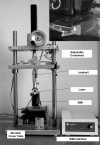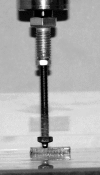Acrylamide Polymer Double-Network Hydrogels: Candidate Cartilage Repair Materials with Cartilage-Like Dynamic Stiffness and Attractive Surgery-Related Attachment Mechanics
- PMID: 26069595
- PMCID: PMC4297135
- DOI: 10.1177/1947603511402320
Acrylamide Polymer Double-Network Hydrogels: Candidate Cartilage Repair Materials with Cartilage-Like Dynamic Stiffness and Attractive Surgery-Related Attachment Mechanics
Abstract
Background: In focal repair of joint cartilage and meniscus, initial stiffness and strength of repairs are generally much less than surrounding tissue. This increases early failure potential. Secure primary fixation of the repair material is also a problem. Acrylamide polymer double-network (DN) hydrogels are candidate-improved repair materials. DN gels have exceptional strength and toughness compared to ordinary gels. This stems from the double-network structure in which there is a high molar ratio of the second network to the first network, with the first network highly crosslinked and the second loosely crosslinked. Previous studies of acrylic PAMPS/PDMAAm and PAMPS/PAAm DN gels demonstrated physicochemical stability and tissue compatibility as well as the ability to foster cartilage formation.
Methods: Mechanical properties related to surgical use were tested in 2 types of DN gels.
Results: Remarkably, these >90%-water DN gels exhibited dynamic impact stiffness (E*) values (~1.1 and ~1.5 MPa) approaching swine meniscus (~2.9 MPa). Dynamic impact energy-absorbing capability was much lower (median loss angles of ~2°) than swine meniscus (>10°), but it is intriguing that >90%-water materials can efficiently store energy. Also, fine 4/0 suture tear-out strength approached cartilage (~2.1 and ~7.1 N v. ~13.5 N). Initial strength of attachment of DN gels to cartilage with acrylic tissue adhesive was also high (~0.20 and ~0.15 N/mm(2)).
Conclusions: DN gel strength and toughness properties stem from optimized entanglement of the 2 network components. DN gels thus have obvious structural parallels with cartilaginous tissues, and their surgical handling properties make them ideal candidates for clinical use.
Keywords: cartilage repair; gels; loss angle; modulus; suturing.
Conflict of interest statement
Figures







References
-
- Mandelbaum BR, Browne JE, Fu F, Micheli L, Mosely JB, Erggelet C, et al. Articular cartilage lesions of the knee. Am J Sports Med. 1998;26(6):853-61. - PubMed
-
- Saris DB, Dhert WJ, Verbout AJ. Joint homeostasis: the discrepancy between old and fresh defects in cartilage repair. J Bone Joint Surg Br. 2003;85(7):1067-76. - PubMed
-
- Mithoefer K, Scopp JM, Mandelbaum BR. Articular cartilage repair in athletes. Instr Course Lect. 2007;56:457-68. - PubMed
-
- Peterson L. Articular cartilage injuries treated with autologous chondrocyte transplantation in the human knee. Acta Orthop Belg. 1996;62 Suppl 1:196-200. - PubMed
-
- Peterson L, Brittberg M, Kiviranta I, Akerlund EL, Lindahl A. Autologous chondrocyte transplantation: biomechanics and long-term durability. Am J Sports Med. 2002;30(1):2-12. - PubMed
LinkOut - more resources
Full Text Sources

